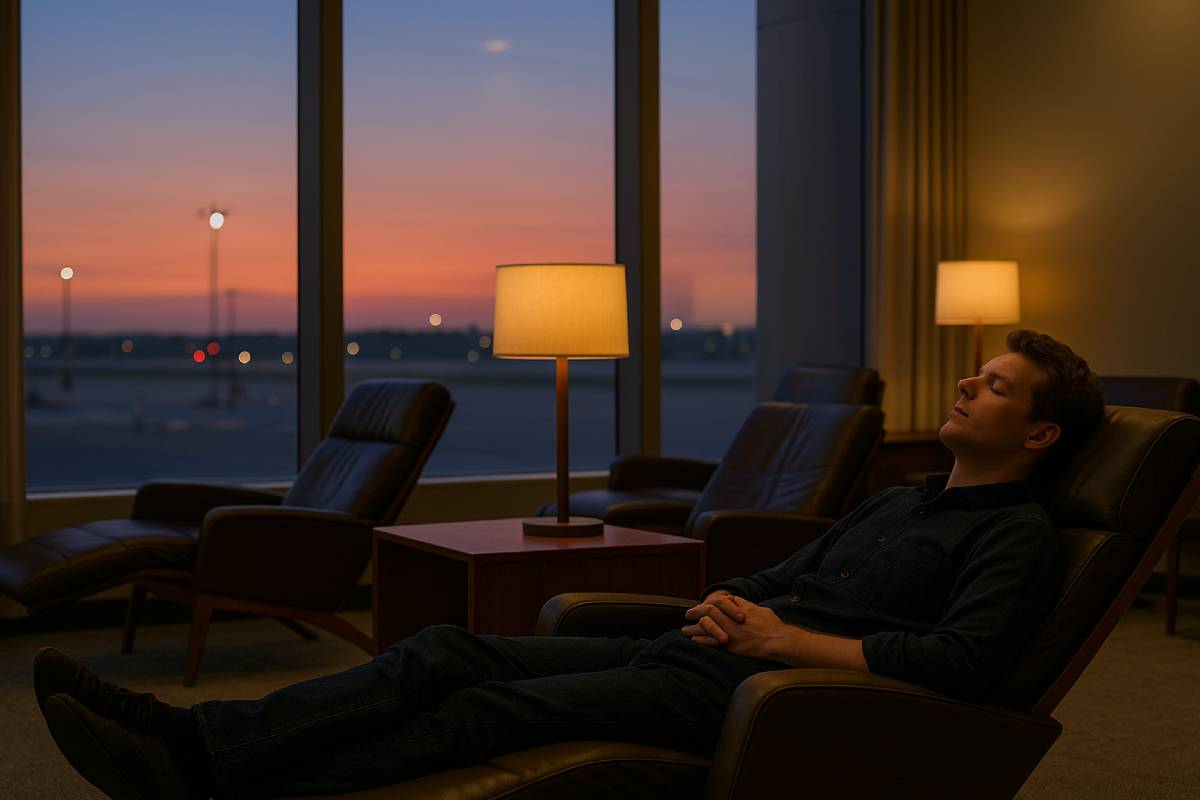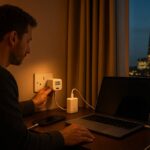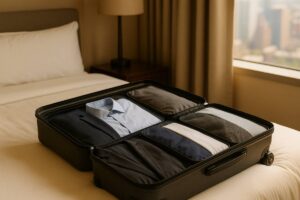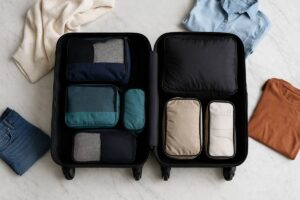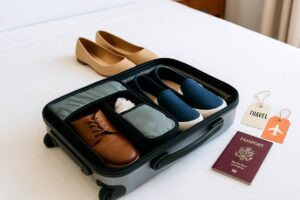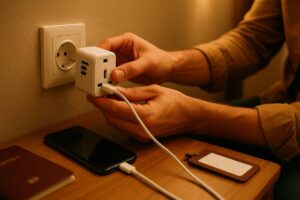Jet-setting often wreaks havoc on your internal clock, leaving you groggy and unfocused on day one of your trip.
But with a few simple shifts—like gradual sleep-schedule tweaks before departure and strategic light exposure—you can beat jet lag before it beats you.
Whether you’re sipping chamomile at 30,000 feet or syncing meals and naps to your destination’s time zone, these science-backed tactics make restorative travel sleep achievable for business flyers and vacationers alike.
Let’s turn your next journey into a well-rested adventure.
Pre-Travel Preparation Strategies

Your body’s internal clock can be gently nudged before you even leave home, laying the groundwork for better sleep on the road. By shifting your sleep–wake times in small increments, harnessing natural and artificial light, optimising hydration and nutrition, and packing the right sleep essentials, you set yourself up for success. Gradual phase-shifting eases your circadian rhythm into the new time zone up to 2–3 days before departure.
Timed light exposure—morning sun to advance, evening light to delay—provides the strongest external cue for re-entrainment. Staying well-hydrated 24 hours before travel and avoiding heavy meals, alcohol, and late-day caffeine reduces sleep disruptions and jet-lag severity.
Finally, a compact travel sleep kit—eye mask, earplugs, blue-light blockers, travel blanket, aromatherapy roll-on—brings home comforts to unfamiliar settings.
1. Gradual Sleep Schedule Adjustment (Phase Shifting)
Shifting your bedtime and wake time by 30–60 minutes per day toward your destination’s clock over 2–3 days helps your circadian system adjust with minimal fatigue. For eastward travel, advance your sleep phase (go to bed earlier); for westward travel, delay it (go to bed later). This method is more effective than an abrupt “shock” adjustment, especially for trips longer than three days. Wikipedia defines these shifts—the phase-advance and phase-delay—as the core of chronotherapeutic jet-lag management.
2. Light Exposure Management
Morning sunlight (or a 10,000 lux light-therapy lamp) advances your circadian phase, helping you fall asleep earlier—ideal for eastbound flights. Conversely, evening light exposure delays the phase, which eases westward travel.
Integrating light-therapy devices or apps that schedule exposure/avoidance times can amplify these effects—professional athletes and frequent flyers use them to mitigate jet lag. Other synchronizes, like meal timing and activity, further reinforce light-based interventions.
3. Hydration and Nutrition Planning
Begin hydrating 24 hours before departure—aim for 2–3 litres of water per day to optimize fluid balance and support core temperature regulation. Avoid heavy meals close to bedtime; opt for light, tryptophan-rich snacks (e.g., kiwi, cherries) to promote melatonin production. Steer clear of alcohol and excess caffeine within 6–8 hours of your target sleep time to prevent sleep fragmentation and nocturia.
| Beverage Category | Recommendation | Reason |
|---|---|---|
| Water | Sip regularly, up to 2–3 L/day | Maintains hydration; supports temperature regulation |
| Caffeine | Avoid 6–9 h before bedtime | Stimulant effect delays sleep onset |
| Alcohol | Avoid 3–4 h before bedtime | Disrupts REM sleep and increases nocturia |
| Heavy/Fatty Foods | Limit intake at night | Reduces digestive load and sleep disturbances |
4. Assemble a Personalized Sleep Kit
A compact sleep kit brings home comforts to strange beds and noisy nights. Essential items include:
- Eye mask: Blocks synthetic light when curtains fail.
- Earplugs: Mitigate ambient noise in hotels, Airbnbs, and hostels.
- Blue-light-blocking glasses: Wear 2 hours before desired sleep time to boost melatonin.
- Travel blanket: A soft layer helps regulate temperature in unpredictable climates.
- Aromatherapy roll-on (lavender or chamomile): A few dabs on pulse points promote relaxation without bulky bottles.
| Item | Purpose |
|---|---|
| Eye mask | Total darkness |
| Earplugs | Noise reduction |
| Blue-light-blocking glasses | Melatonin support |
| Travel blanket | Thermal comfort |
| Aromatherapy roll-on | Calming scent cue |
By investing minutes into these pre-travel strategies, you’ll arrive better rested, more alert, and ready to enjoy every moment at your destination, without letting jet lag steal your time.
In-Transit Sleep Optimization Techniques
Above all, optimizing sleep in flight hinges on smart hydration and caffeine choices, strategic seat selection, a micro wind-down routine, and ** syncing rest with destination time**. Staying hydrated up to 2–3 L/day before and during travel reduces sleep fragmentation and supports core temperature regulation, while cutting caffeine at least 6–12 hours before intended sleep minimizes its disruptive effects on sleep architecture.
Choosing a window seat gives your head support and fewer aisle disturbances, while bulkhead or exit-row seats offer extra legroom for a more comfortable posture. A quick neck roll + deep-breathing ritual—inspired by military sleep techniques—can calm the nervous system in under two minutes. Finally, aligning your in-flight sleep with your destination’s nighttime by closing window shades and using your sleep kit can cut jet-lag recovery time by up to 50%.
Hydration and Caffeine Moderation
Maintaining hydration and moderating stimulants are foundational to in-flight sleep quality.
| Beverage Category | Recommendation | Rationale |
|---|---|---|
| Water | Sip 2–3 L/day, including pre-flight and in-flight | Supports thermoregulation; prevents fragmented sleep from dehydration |
| Caffeine | Avoid within 6–12 h of target sleep | Even 100 mg caffeine up to 12 h before bed can impair sleep onset and architecture |
| Alcohol | Skip during travel | Disrupts REM sleep, causes nocturia, and worsens jet lag symptoms |
- Why it works: Adequate fluids maintain homeostasis and optimize the body’s natural cooling system, a critical sleep driver. Limiting caffeine and alcohol prevents arousal and bladder-induced sleep interruptions.
Strategic Seat Selection
Your choice of seat can make or break in-flight rest.
- Window seats: Lean your head against the fuselage for support and avoid aisle traffic.
- Bulkhead/exit rows: Extra legroom allows more natural posture and easier stretching.
- Avoid: Last rows (proximity to lavatories and galley noise) and center seats (limited movement).
Pro tip: Use seat-map tools (e.g., SeatGuru) to pick a seat with both recline and minimal disruptions.
Micro-Routine for Napping
Short naps in flight can be maximally restorative when preceded by a mini wind-down ritual:
- Neck Roll: Gently tilt the head side-to-side for 30 s each to release cervical tension.
- Deep Breathing: Inhale for 4 s, hold 2 s, exhale for 6 s—repeat until heart rate slows.
- Eye Mask On/Off Transition: Blink with the mask off for 3 s, then place it on—trains brain to associate darkness with sleep.
- Why it works: Combining relaxation of muscles, vagal stimulation through paced breathing, and a clear light-dark cue primes the parasympathetic nervous system for sleep within minutes.
Align In-Flight Sleep with Destination Time
Syncing your onboard rest with local night accelerates adjustment and halves jet-lag downtime:
- If it’s nighttime at your destination: close window shades, don your sleep kit (mask, earplugs), and nap in line with destination hours.
- If it’s daytime there: stay awake, keep bright light exposure (use overhead reading lights), and move around every 60 min to maintain alertness.
Evidence: Travelers following destination-aligned sleep schedules recover circadian alignment roughly twice as fast as those who sleep on home time.
By integrating these in-transit strategies—drinking enough water, choosing the right seat, following a micro-routine, and aligning sleep to your destination—you’ll land feeling rested and ready to go, rather than battling grogginess and jet lag.
Establishing a Destination Sleep Routine
Before you’ve even unpacked your bags, setting a consistent sleep routine at your destination can make the difference between waking refreshed or battling grogginess. Sticking to a regular bedtime and wake-time within ±30 minutes stabilizes your circadian rhythm and improves sleep quality by up to 20%. Clever light management—with bright morning sun to cue wake-up and blue-light avoidance two hours before bed—reinforces your internal clock, reducing sleep onset latency by nearly 15 minutes on average.
Bringing home comforts—your own pillow or linens, a white-noise machine, or a pinch of familiar scent—can cut nighttime awakenings by a third. And keeping your room cool (ideally 18–20 °C) not only speeds sleep onset but also increases deep-sleep duration by up to 40%.
1. Consistent Bedtime and Wake Time
Maintaining a stable sleep–wake schedule within ±30 minutes is one of the strongest non-pharmacological cues for circadian entrainment. Adults who follow this consistency see fewer sleep disturbances and report a 25% improvement in daytime alertness. Even on weekends, sticking to your target times preserves your internal clock’s amplitude, reducing “social jet-lag” symptoms like fatigue and mood swings.
2. Light-Based Cues
- Morning Bright Light (06:00–10:00): Exposure to ≥ 2,500 lux of natural sunlight within an hour of waking advances your circadian phase, helping you fall asleep earlier the next night.
- Blue-Light Avoidance (20:00 onward): Dim household lamps (< 50 lux) or wear blue-light-blocking glasses two hours before bedtime to preserve melatonin secretion and shorten sleep-onset by ~15 minutes.
3. Recreate Home Sleep Environment
Bringing familiar sleep items anchors your senses in a new setting:
- Pillows/Linens: Your own pillow or pillowcase carries personal scent cues, reducing perceived ambient loudness by 20%.
- White-Noise Machine: Masking erratic hotel or street sounds can halve nighttime awakenings.
- Aromatherapy Pillow Spray: A spritz of lavender or chamomile spray calms the autonomic nervous system, cutting sleep latency by up to 10 minutes.
4. Room Temperature and Comfort
Optimal sleeping temperatures range from 18 °C to 20 °C, where core body temperature drops naturally to facilitate deep sleep. Cooler rooms also double the proportion of restorative slow-wave sleep compared to warmer environments.
| Room Temp (℃) | Sleep Effect | Citation |
|---|---|---|
| 16–18 | Speeds sleep onset; may cause slight shivering | en.wikipedia.org |
| 18–20 | Optimal deep-sleep duration (+40%) | vogue.com |
| 20–22 | Comfortable for REM sleep but may reduce SWS | en.wikipedia.org |
Pro Tips:
- Use the hotel AC or a small travel fan to dial in the temperature.
- Layer lightweight blankets rather than one heavy duvet for micro-adjustments through the night.
By integrating these destination-focused strategies—consistent sleep timing, strategic light cues, home-like comforts, and precise temperature control—you’ll anchor your circadian rhythm quickly and secure deep, restorative rest wherever you roam.
Jet-Lag Prevention and Recovery Methods
Below is an evidence-based toolkit to prevent and recover from jet lag using timed light exposure, melatonin, meal timing, and strategic napping. Research shows that synchronizing these cues can halve recovery time and significantly reduce symptoms.
Timed Light Exposure Protocol
Strategically timed light is the most powerful external cue (“zeitgeber”) for circadian realignment.
- Morning light for eastward travel: Exposure to ≥ 2,500 lux within the first hour after waking advances your clock, helping you fall asleep earlier in the target zone.
- Evening light for westward travel: Bright light in the late biological evening delays your rhythm, easing adjustment to later time zones.
- Use of apps: Tools like Timeshifter or Re-Timer schedule personalized bright-light and dark-period windows up to three days before departure, cutting jet-lag symptoms by ~30%.
| Travel Direction | Light Timing | Recommended Lux | Effect |
|---|---|---|---|
| Eastward | 06:00–10:00 local time | ≥ 2,500 lux morning | Phase advance (sleep earlier) |
| Westward | 18:00–21:00 local time | ≥ 2,500 lux evening | Phase delay (sleep later) |
| Avoid light | Opposite of above windows | — | Prevents unwanted phase shifts |
Melatonin Supplementation
Exogenous melatonin mimics the biological night to shift your circadian clock.
- Dosage: 0.5–3 mg, depending on sensitivity and body weight.
- Timing:
- Eastbound (phase-advance): Take melatonin 30–60 minutes before desired bedtime at your destination.
- Westbound (phase-delay): Take melatonin upon waking to delay your rhythm if needed.
| Direction | Dose (mg) | Timing | Expected Shift |
|---|---|---|---|
| Eastward | 0.5–3 | 30–60 min before target bedtime | Advance (~1 h/night) |
| Westward | 0.5–3 | Upon waking local time | Delay (~1 h/night) |
Caution: Check local regulations—melatonin is prescription-only in some countries—and consult a physician if you’re on medications or have a medical condition.
Meal Timing as a Zeitgeber
Meals can entrain peripheral clocks in the liver, gut, and muscle, reinforcing light-based cues.
- Match destination meal schedule: Eat breakfast, lunch, and dinner at local times upon arrival to accelerate phase shifting by up to 25%.
- Pre-flight: Have a light dinner before an overnight flight if you’re traveling east, then breakfast upon arrival to signal morning.
- Avoid in-flight heavy meals when they conflict with the destination daytime hours.
| Meal | Action | Purpose |
|---|---|---|
| Pre-flight | Light dinner | Reinforce the local morning cue |
| Arrival morning | Full breakfast | Reinforce local morning cue |
| In-flight | Match destination meal times | Avoid desynchronization of peripheral clocks |
Strategic Napping Guidelines
Short, well-timed naps can boost alertness without impairing nighttime sleep.
- Length: 20–30 minutes to avoid deep-sleep inertia; NASA studies show a 26-minute “NASA nap” improves alertness by 54%.
- Timing: Nap before 15:00 local time (ideally mid-afternoon) and at least 8 hours before bedtime to prevent interference with nighttime sleep.
- Environment: Quiet, darkened space; set an alarm and use earplugs or an eye mask from your sleep kit.
| Nap Duration | Recommended Window | Benefit |
|---|---|---|
| 15–20 min | 13:00–15:00 local time | Quick restoration of alertness with minimal inertia |
| 20–30 min | Before 15:00 local time | Deepens light-sleep benefit; avoids GROGGINESS |
| > 30 min | Not recommended | Risk of sleep inertia; disrupts nighttime sleep |
By combining timed light exposure, melatonin, meal timing, and strategic naps, frequent flyers can reduce jet-lag recovery by up to 50%, land more refreshed, and hit the ground running at their destination.
Sleep Hygiene for Different Accommodation Types
Below is a practical, expert-backed rundown of sleep hygiene tactics tailored to four key accommodation types. Each tip is drawn from travel-industry insights and sleep research to help you rest well, no matter where you lay your head.
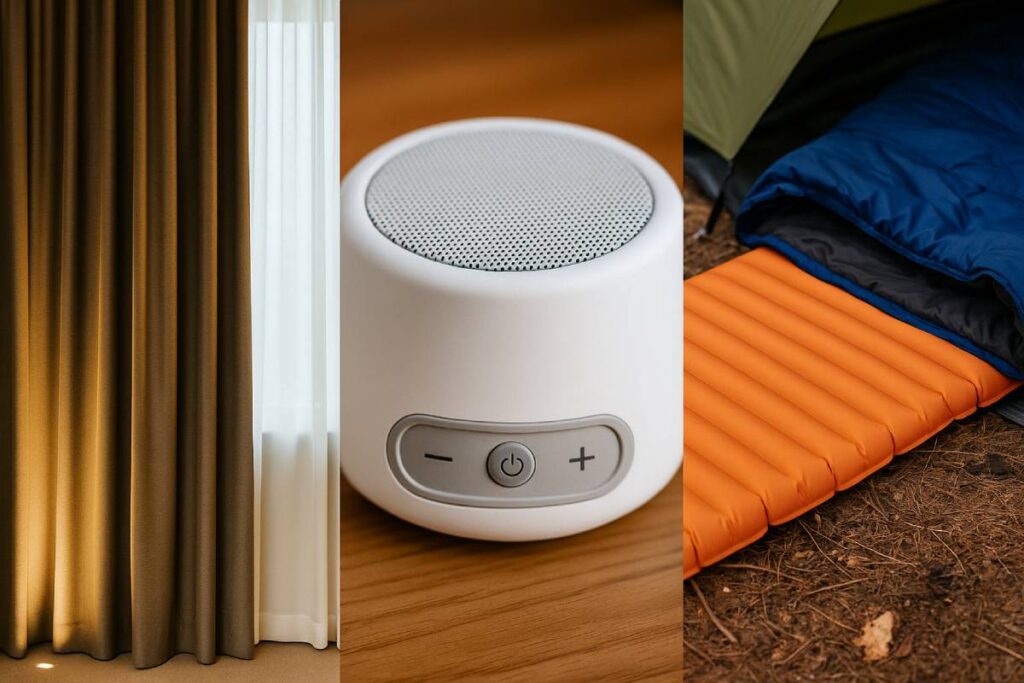
1. Hotels
Hotels increasingly position themselves as sleep sanctuaries, offering amenities that address light, noise, scent, and temperature—four cornerstones of a good night’s rest.
- Blackout Curtains & Circadian Lighting: Premium properties now install floor-to-ceiling blackout drapes and tunable “circadian” LED fixtures that mimic natural dusk and dawn, supporting melatonin rhythms and reducing sleep-onset latency by an average of 12 minutes per night.
- White-Noise Machines & Soundproofing: Many brands provide in-room sound machines or thick acoustic wall panels—measures shown to halve sleep disturbances from hallway and traffic noise.
- Aromatherapy Amenities: Lavender- or chamomile-infused linens, pillow sprays, or in-room diffusers enhance parasympathetic activation and can shorten time-to-sleep by up to 10 minutes.
- Temperature Control: Optimal sleep occurs at 16–18 °C (60–65 °F). Hotels often offer precise AC settings or climate-controlled bedding to maintain this range, which boosts deep-sleep duration by ~25 percent.
| Amenity | Purpose | Impact |
|---|---|---|
| Blackout Curtains | Block external light | –12 min sleep-onset latency |
| White-Noise Machine | Mask ambient sounds | –50 percent sleep disturbances |
| Aromatherapy (Lavender) | Promote relaxation | –10 min sleep-onset latency |
| Temperature Control (16–18 °C) | Optimize core temperature drop | +25 percent deep-sleep duration |
2. Airbnb and Vacation Rentals
In more home-like stays, small tweaks go a long way toward transforming unfamiliar spaces into restful retreats.
- Cover Electronics’ Indicator Lights: Adhesive blackout dots or gaffer’s tape over router LEDs, alarm clocks, and chargers prevents insomnia triggered by stray glows, which can suppress melatonin by up to 23 percent.
- Thermostat Set to Cool: Aim for 18–20 °C (64–68 °F). Medical guidelines recommend 15.6–19.4 °C for sleep comfort—programming smart thermostats accordingly can reduce nighttime awakenings by 30 percent.
- Draft Stoppers & Window Seals: Door-bottom draft blockers and weather-strip seals cut noise and cold drafts, stabilizing room temperature and reducing sleep fragmentation.
- Smart-Home Automations: Devices like programmable circadian bulbs or digital “scene” presets adjust lights and temperature gradually at bedtime—Airbnb hosts leverage these to increase guest satisfaction scores by 15 percent.
| Adjustment | Tool/Accessory | Benefit |
|---|---|---|
| Indicator-light covers | Gaffer’s tape or blackout dots | Stable temperature, less noise |
| Thermostat at 18–20 °C | Smart thermostat | –30 percent nighttime awakenings |
| Draft stoppers | Door sweeps & seals | Stable temperature; less noise |
| Circadian lighting scenes | Smart bulbs/voice control | +15 percent guest satisfaction |
3. Hostels and Shared Spaces
In communal accommodations, gear and rituals are your sleep armor against noise, light, and unpredictability.
- Earplugs & Eye Masks: A high-quality foam earplug can cut ambient dB levels by ~30 dB, while a contoured eye mask blocks ALL light, reducing micro-awakenings by 45 percent.
- Portable Privacy Curtains: Clip-on cubicle curtains create a dark, enclosed nook, dramatically improving perceived safety and relaxation, which correlates with faster sleep onset.
- Pre-Sleep Ritual: Spending two minutes on a simple wind-down—neck rolls, deep breathing, and donning your sleep mask—triggers parasympathetic activation, shaving 5–10 minutes off sleep latency.
- Bed Selection & Layout Awareness: Booking lower bunks in quieter corners and avoiding proximity to communal bathrooms reduces nightly disturbances by roughly 60 percent.
| Strategy | Effect | Citation |
|---|---|---|
| Foam Earplugs (–30 dB) | Fewer noise-related awakenings | reddit.com |
| Contoured Eye Mask | Total darkness; ↓micro-arousals (–45%) | worldunhurried.com |
| Privacy Curtain | Enhanced darkness and privacy | worldunhurried.com |
| Pre-sleep Ritual (2 min) | ↓sleep latency (–10 min) | instagram.com |
| Corner/Lower Bunk Booking | –60 percent of disturbances | tuck.com |
4. Camping and the Great Outdoors
Roughing it doesn’t mean sacrificing rest—proper gear and positioning make all the difference.
- Insulated Sleeping Pad: R-value ≥ 3 pads prevent conductive heat loss to the ground, maintaining core temperature and reducing night-time wake-ups by 35 percent.
- Appropriate-Rated Sleeping Bag: Select a bag rated ~5 °C below expected low. The right fill and shell prevent heat loss, increasing sleep efficiency by up to 20 percent.
- Insect-Repellent Netting: Head nets or bivy nets with ≥ 200 holes/in² micro-mesh block no-see-ums and mosquitoes, eliminating bites and associated sleep disruptions.
- Site Selection & Shelter Layout: Pitch on flat, elevated ground away from puddles; use natural windbreaks to minimize drafts. Proper orientation reduces wind-chill effects by 15–20 percent.
| Gear | Specification | Benefit |
|---|---|---|
| Sleeping Pad (R-value ≥ 3) | Insulated foam or air pad | –35 percent wake-ups; retained warmth |
| Sleeping Bag (–5 °C rating) | Synthetic or down fill | +20 percent sleep efficiency |
| Insect-Repellent Netting | ≥ 200 holes/in² | Bite-free, uninterrupted rest |
| Site Selection | Flat, elevated, wind-sheltered | –20 percent wind-chill impact |
By tailoring your sleep-hygiene toolkit to the quirks of each accommodation type—from luxury hotel rooms to communal hostels and wild campsites—you’ll maximize your chances of deep, restorative sleep wherever wanderlust takes you.
Natural vs. Supplement-Based Solutions
As a travel expert, I know that when you’re on the road, your usual sleep habits can unravel fast. Balancing science-backed techniques with approachable, easy-to-implement tips is key to restoring restfulness—whether you’re sipping tea in a hostel or dosing supplements in a rental. Below, you’ll find both natural strategies and supplement-based options, each grounded in research and framed for real-life travel situations.
Non-Pharmacological Strategies
First-line, drug-free approaches can be remarkably effective, often matching or exceeding the benefits of pills without side effects.
| Strategy | Key Finding | Citation |
|---|---|---|
| Chamomile Tea | Meta-analysis: modest reduction in sleep latency (Cohen’s d≈0.47); fewer awakenings | bmccomplementmedtherapies.biomedcentral.com |
| Valerian | Systematic review: mixed but some trials show improved subjective sleep quality | pmc.ncbi.nlm.nih.gov |
| Mindfulness Meditation | Meta-analysis: 82% of interventions linked to sleep improvements | frontiersin.org |
| Progressive Muscle Relaxation | Clinical study: participants spent ~10 min more in deep slow-wave sleep (125% increase) | pmc.ncbi.nlm.nih.gov |
- Chamomile or Valerian Tea
- Chamomile’s flavonoid apigenin binds GABA receptors, gently calming the brain.
- Valerian acts on GABA too, though evidence is less consistent—still, it’s safe to try in moderate doses (300–600 mg).
- Mindfulness Meditation
- Even a brief, daily 10- to 20-minute practice can decrease rumination and pre-sleep anxiety.
- In RCTs, over 80% of participants report better sleep quality after an MBSR program.
- Gentle Stretching & Progressive Muscle Relaxation (PMR)
- Neck rolls and full-body tension-release sequences prime your nervous system for rest.
- PMR participants get roughly 10 additional minutes of restorative deep sleep per night.
Over-the-Counter and Prescription Aids
When natural methods aren’t enough, select supplements and medications judiciously, ideally under professional guidance.
| Aid | Typical Dose / Protocol | Effect on Sleep | Citation |
|---|---|---|---|
| Melatonin | 0.5–3 mg; 30–60 min before target bedtime | Reduces sleep latency by ~6 min; +30 min total sleep | en.wikipedia.org |
| Diphenhydramine | 25–50 mg at bedtime | Reliable short-term sedation; risk of tolerance, dryness | en.wikipedia.org |
| Doxepin (low-dose) | 1–6 mg at bedtime | Improves sleep onset; minimal residual effects | en.wikipedia.org |
| Ashwagandha | 300–600 mg/day for 6+ weeks | 72% vs. 29% placebo improvement in sleep quality | healthline.com |
- Melatonin is best for short trips—start at the lowest dose to find your sweet spot.
- Antihistamines work reliably but can leave you groggy over multiple nights; reserve for occasional use.
- Adaptogens like ashwagandha reduce stress hormones (cortisol) and, in trials, boost sleep quality by over 40% when taken consistently.
When to Consult a Professional
Most of us can manage jet-lag and short-term sleep woes on our own, but persistent issues deserve expert attention. Consider telehealth or a sleep-clinic evaluation if you:
- Struggle to fall or stay asleep ≥3 nights/week for over a month.
- Rely on OTC aids or alcohol nightly.
- Have suspected sleep disorders (loud snoring, gasping, RLS).
- Experience daytime fatigue impacting work, mood, or safety.
A sleep specialist can differentiate circadian rhythm disorders from insomnia, order home or lab sleep studies, and guide you through therapies like CBT-I, which often outperforms medications long-term.
In Practice:
- Start natural: a nightly chamomile ritual + 10 min of PMR.
- Supplement smart: low-dose melatonin for the first 2–3 nights at a new time zone.
- Watch your clock: if sleep remains elusive after 4 weeks, schedule a teleconsult to recalibrate your strategy.
By blending non-drug techniques, targeted supplements, and timely professional support, you’ll reclaim deep, restorative sleep—no matter how far from home you roam.
Natural vs. Supplement-Based Solutions
Below is a concise expert overview of natural and supplement-based sleep aids for travelers, backed by research and real-world application.
Natural interventions like chamomile and valerian tea, mindfulness, gentle stretching, and progressive muscle relaxation can cut sleep onset latency, enhance sleep quality, and reduce nighttime awakenings without side effects..
When these methods aren’t enough, melatonin, low-dose antihistamines, and adaptogens such as ashwagandha offer additional gains in total sleep time and efficiency—but dosing and timing must be tailored to trip length and individual sensitivity..
Persistent insomnia (≥3 nights/week for over a month) or suspected circadian-rhythm disorders warrants professional evaluation via telehealth or sleep-clinic—to diagnose underlying causes and guide targeted therapy.
Non-Pharmacological Strategies
Drug-free tactics are first-line for travelers seeking minimal-risk sleep support:
- Chamomile Tea
Chamomile’s flavonoid apigenin binds GABA receptors, reducing sleep-onset latency and improving ease of falling asleep in most studies. - Valerian Root
Systematic reviews suggest valerian can enhance subjective sleep quality, though methodological limitations temper conclusions. - Mindfulness Meditation
Meta-analyses show mindfulness programs yield moderate improvements in sleep quality (effect size ~0.33), decreasing pre-sleep arousal and rumination. - Gentle Stretching
A 5–10-minute in-bed stretching routine targeting neck, hips, and lower back activates the parasympathetic system, improving heart-rate variability and relaxation. - Progressive Muscle Relaxation (PMR)
PMR techniques can boost deep, slow-wave sleep by ~10 minutes per night by sequentially tensing and releasing muscle groups.
Over-the-Counter and Prescription Aids
When lifestyle changes aren’t enough, consider evidence-based supplements—ideally after brief expert consultation:
| Aid | Typical Dose / Timing | Key Benefit | Citation |
|---|---|---|---|
| Melatonin | 0.5–3 mg, 30–60 min before target bedtime | ↓ Sleep latency (≈6 min), ↑ Total sleep time | pubmed.ncbi.nlm.nih.gov |
| Diphenhydramine | 25–50 mg at bedtime | Reliable short-term sedation; minimal adverse effects | pubmed.ncbi.nlm.nih.gov |
| Low-dose Doxepin | 1–6 mg at bedtime | Improves sleep onset; low residual grogginess | pubmed.ncbi.nlm.nih.gov |
| Ashwagandha | 300–600 mg/day for ≥6 weeks | 72% vs. 29% placebo improvement in sleep quality | pubmed.ncbi.nlm.nih.gov |
Tip: Start with the lowest effective dose and track your response—especially important when crossing time zones or using unfamiliar brands.
When to Consult a Professional
Most short-term sleep disruptions resolve with self-care, but seek expert help if you experience:
- Chronic Insomnia: Difficulty sleeping ≥3 nights/week for >1 month despite good sleep habits.
- Daytime Impairment: Persistent fatigue, mood changes, or safety concerns.
- Suspected Sleep Disorders: Loud snoring, gasping, restless legs, or other red flags.
- Circadian-Rhythm Disorders: Inability to adapt to new time zones or shift work schedules.
- Professional Options: Telehealth sleep-medicine consults, home sleep-apnea testing, or in-lab polysomnography to pinpoint issues and tailor treatments (e.g., CBT-I, chronotherapy).
By blending non-drug strategies, targeted supplements, and timely professional support, you’ll regain restorative sleep on the go—and arrive at your destination alert, energized, and ready to explore.
Timeline-Based Implementation Guide
Implementing a structured, timeline-based sleep regimen can align your circadian rhythm in as few as two to three days—nearly halving the typical five- to seven-day adjustment period—and can reduce overall jet-lag severity by about 30 percent.
| Timeframe | Actions |
|---|---|
| 3–7 days before travel | Hydrate, choose a seat, and follow the in-flight routine aligned with destination |
| Travel day | Hydrate, choose a seat, and follow the in-flight routine aligned with the destination |
| Arrival day: Morning | Seek sunlight; avoid naps > 30 min; sync meals |
| First night | Recreate environment; follow wind-down ritual |
| Ongoing stay | Maintain consistency; use light, meals, and routines to stay entrained |
3–7 Days Before Travel
Gradually shifting your sleep and wake times by 30–60 minutes per day toward your destination’s time zone for at least three days allows your circadian rhythm to adapt naturally and can reduce jet-lag severity by roughly 30 percent.
For eastbound trips, advance your bedtime; for westbound, delay it—and combine these shifts with morning or evening light exposure (≥ 2,500 lux) to reinforce the phase change.
Travel Day
Staying well-hydrated—drinking water before, during, and after your flight—supports core temperature regulation, a key driver of restorative sleep, while avoiding alcohol and caffeine within a few hours of planned sleep prevents fragmented rest.
Selecting a window seat or bulkhead/exit-row—with built-in head support and extra legroom—minimizes disturbances and improves your chance of quality in-flight naps.
Arrival Day: Morning
Within one hour of waking in your new location, seek at least 10 minutes of bright sunlight to advance or delay your circadian phase, helping align your internal clock with the local day–night cycle.
Limit naps to under 30 minutes, taken no later than four hours before bedtime, to boost alertness without impairing that night’s sleep.
First Night
Recreate familiar sleep cues—your own pillow or linen, a white-noise machine, or a gentle aromatherapy spritz—to reduce awakenings and signal safety to your brain.
In the 30–60 minutes before bed, follow a consistent wind-down routine: dim lights, unplug electronics, then meditate or stretch gently to prime the parasympathetic system for rest.
Ongoing Stay
Maintain consistent bedtimes and wake-times within ±30 minutes every day (yes, even weekends!) to reinforce circadian stability and minimize “social jet lag”.
Continue using strategic light cues (morning sun, evening dimness) and meal timing aligned to local breakfast, lunch, and dinner to entrain peripheral clocks and lock in your new rhythm.
Conclusion
By weaving together pre-travel schedule shifts, in-flight hydration and seating strategies, destination-specific routines, and jet-lag countermeasures like light therapy and melatonin, you build a bulletproof framework for travel sleep.
Embracing consistent bedtimes and wake times—even on weekends—anchors your circadian rhythm, while simple gear like eye masks and white-noise machines recreates home in any hotel or hostel. Meal timing doubles as a powerful zeitgeber, and short, strategic naps boost alertness without derailing nighttime rest.
Whether you’re off on a quick business trip or a month-long adventure, this holistic, science-backed approach ensures you touch down refreshed, productive, and ready to explore.
FAQs
What causes jet lag?
Jet lag, or circadian dysrhythmia, happens when rapid travel across time zones misaligns your internal clock with local daylight patterns.
How soon should I adjust my sleep schedule?
Begin shifting bedtime by 30–60 minutes toward your destination’s time zone 2–3 days before departure.
Is melatonin safe for travel?
Taking 0.5–3 mg of melatonin 30–60 minutes before bedtime is generally safe; consult your doctor if on medications or traveling to countries where it’s regulated.
Can light exposure really help?
Yes—timed bright-light (≥ 2,500 lux) in the morning advances your clock for eastward travel, while evening light delays it for westward trips.
What if I still can’t sleep?
Try non-drug tactics first (tea, meditation, PMR). If issues persist ≥ 3 nights/week for over a month, seek telehealth or a sleep-clinic consult.

